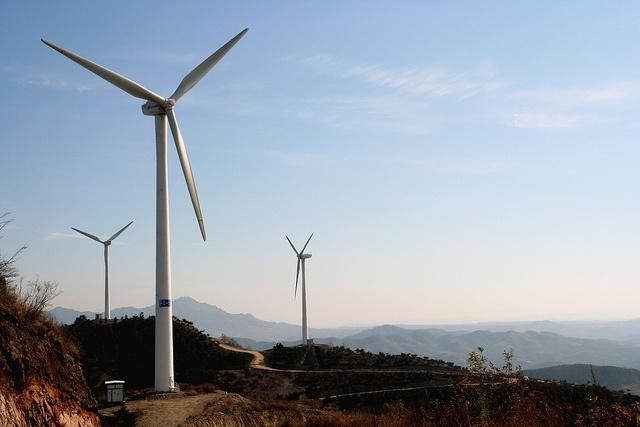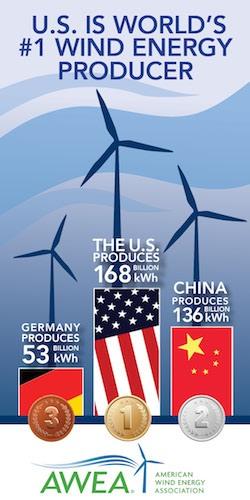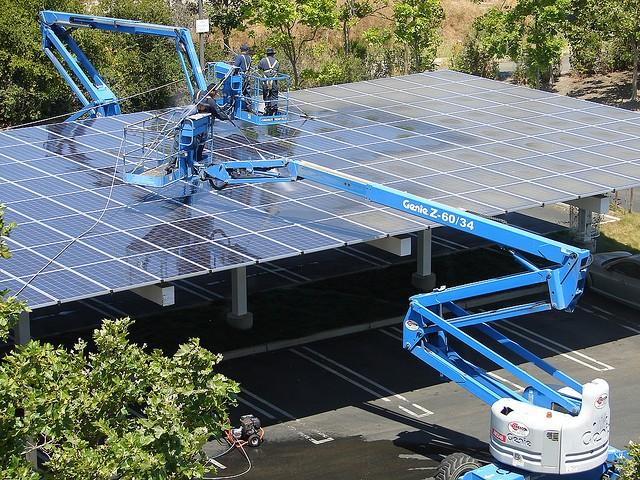China’s 20% Renewable Energy Commitment Challenges U.S. Utility Industry


The U.S. electric utility industry now confronts a new disruptive business reality from China’s announced commitment to source 20 percent of its energy from renewable technologies like solar and wind. This commitment is not a “non-binding charade,” as characterized by Republican Sen. James Inhofe of Oklahoma.
China faces an environmental wall that blocks its continued economic growth. The country must restore the healthiness of its air, water and food or confront a costly degradation in worker health. China has no choice but to shift toward zero-emissions renewable energy.
China’s massive commitment to renewable energy will create economies of scale that will shatter current price levels around the world. Its success will bring to scale the technologies and processes required to integrate renewable energy into an electrical grid. China is on a path that will push the U.S. electric utility industry over a renewable energy cliff.
California + China = Accelerated disruption
The California coastal cities of San Francisco, Los Angeles and San Diego are the recognized global capitals of disruptive technology. These cities are the global headquarters for disruptive technology companies including Apple, Facebook, Qualcomm, Pixar, Tesla and General Atomics (drones). Their serial entrepreneurs, sourced from around the world, are creating the next generation of disruptive technologies.
The state’s political leadership embraces technology disruption most especially in clean tech. California actually has a more ambitious renewable energy goal than China’s. California, the seventh largest economy in the world if it were a separate nation, has the goal of achieving 30 percent of its electricity from renewable energy by 2020. It has also adopted building codes that target achieving zero-net-energy residential buildings by 2020 and zero-net-energy commercial buildings by 2030. The state has the world’s second largest carbon cap-and-trade program that targets the pricing of emissions to achieve a 16 percent reduction by 2020. California’s electric utilities are pioneering new regulatory relationships, technologies and processes to offer their customers cleaner energy and lower electric bills.
The U.S. electric utility industry should take notice that China and California are working together to realize the scaling of renewable energy. The U.S.-China Green Energy Council headquartered in Silicon Valley has as its mission “… to promote and strengthen U.S. and China collaboration in Green Energy by facilitating high impact clean-tech collaborative initiatives and projects between the U.S. and China and serving as a platform for the integration of policy, business, investment, and R&D projects for the two countries.” The electric utility industry’s 21st century strategic issue is that the world’s leading manufacturer and the world’s capital for disruptive technologies are collaborating in the development of renewable energy on a disruptive scale.
Transforming the electric utility industry
For most utility CEOs, the transformative forces impacting their utility are top of mind. The electric utility industry recognizes change is coming, and CEOs are heavily engaged in accessing how to incorporate change into their processes. And that may well be the industry’s Achilles heel.
History points to disruptive change never being a managed and smooth process. It was not for IBM or Nokia or Sears, and it will not be for the electric utility industry. Here are three best practices harvested from observing and participating in disruptive changes while working alongside Silicon Valley entrepreneurs:
1. Disruption is customer focused. A lower electricity bill is the key electric utility customer’s “want.” Distributed solar and battery technology companies, most visibly SolarCity, have as their disruptive mission the sale of technologies that will deliver guaranteed lower electricity bills. The company's alliance with finance companies to offer zero-down, guaranteed lower electricity bill financing packages has catapulted sales to record levels. Fundamentally, the electric utility industry lacks a business model for offering its customers guaranteed lower electricity bills. Restoring what was once the justification for the creation of an electric utility monopoly is the industry’s mission-critical transformative challenge.
2. Revenue preservation is a strategic error. It seems logical that a professionally managed company with a talented workforce should be able to manage change to preserve revenues, while also incorporating a disruptive technology path that offers new revenue growth. But logic does not win in a disruptive environment. Fierce and singularly-focused competition for the customer is what drives success in a disruptive environment. The U.S. electric utility industry has a huge competitive advantage through its monopoly relationship with customers. But that monopoly position has the potential of being challenged by China’s and California’s pursuit of disruptive electricity technologies that could deliver lower customer bills and reduced emissions, plus higher reliability without a grid connection. Aligning with the disruptive revenue growth opportunity, rather than seeking to preserve revenues, has historically been the successful strategy in a disruptive business environment.
3. Culture is critical. Jack Ma, the founder of Alibaba and the richest man in China, focuses his business culture on the customer first. Steve Jobs had a singular focus on elegant design that wowed the customer. Mark Zuckerberg’s vision is to reorganize the world’s information around people.
My experience within the electric utility industry is: While utilities engage in considerable customer service activities, the culture is heavily focused on itself. The electric utility industry’s culture is still rooted in the 20th century’s scientific management business practices of command and control. The industry's cultural bias is to create purposeful, not disruptive, change through a process of analysis, consensus and regulatory approval. While the disruptive threat to the electric utility industry is technological, it will be its cultural ability to initiate disruptive change that will shape its role in supplying customers with guaranteed lower bills, reduced emissions and improved reliability supplied through renewable energy.
Image credit: Flickr/our-planet
Bill Roth is an economist and the Founder of Earth 2017. He coaches business owners and leaders on proven best practices in pricing, marketing and operations that make money and create a positive difference. His book, The Secret Green Sauce, profiles business case studies of pioneering best practices that are proven to win customers and grow product revenues. Follow him on Twitter: @earth2017
Can Nuclear Fusion Save the Planet?


Our ability to transition from fossil fuels to renewable sources of energy will likely determine the fate of the planet. Some countries are making progress toward this goal, using solar, wind and water power. In the historic deal struck on Wednesday between the U.S. and China, for instance, China pledged that solar and wind power would account for 20 percent of China’s total energy production by 2030. Denmark, which aims to completely eliminate its use of fossil fuels by 2050, will rely on its cutting-edge wind power industry. Germany has focused on solar and wind power in its push to remake its electricity system, and Brazil now derives more than 75 percent of its electricity from hydro-power sources.
Yet, the real 'solution' to global warming may lie in a fourth renewable energy source, and one about which we typically hear almost nothing: nuclear fusion.
The science
Nuclear fusion isn’t new. In fact, the oldest thermonuclear reactor is approximately 13 billion years old or the approximate age of the universe and the first star. Our most popular fusion reactor is the sun. Explaining the real science behind nuclear fusion is best left to the experts, but the short of it is that fusion, the reaction that gives stars their energy, is the opposite of fission. Whereas nuclear fission creates energy by splitting one atom into two, fusion does it by joining two (hydrogen) atoms together to create one (helium), and the resulting reaction releases neutrons and an unbelievable amount of energy.
As it turns out, this is quite difficult, because in order to get the nuclei of two hydrogen atoms to fuse, one must defeat the protons’ natural tendency to repel each other. Overcoming this tendency requires temperatures of over 100 million Kelvin (~six times hotter than the temperature at the sun’s core) and incredibly high pressure. The prevailing method for accomplishing this is known as magnetic confinement, using a reactor known as a tokamak, and it is impossible to understand. (There’s also another method that involves lasers, and it is even more confusing.)
Humans have been experimenting with nuclear fusion since the 1950s, and the scary amount of energy released by a fusion reaction was the impetus for the hydrogen bomb. As our own RP Siegel pointed out, the goal of those working to turn nuclear fusion into a renewable energy source -- as opposed to a weapon -- is to take the science behind the H-bomb and control it, thereby allowing for the gradual (and self-sustaining) release of energy. Unfortunately, doing this has heretofore proved impossible.
The challenges
We owe our fusion failures to the the incredible temperature and pressure required to ignite a fusion reaction. Fusion demands an enormous energy input, which is almost always greater than the energy it creates, resulting in a net energy loss. Second, because fusion scientists are effectively setting out to create a star contained by a magnetic bottle (or pounded by lasers), the necessary materials are either too expensive or simply do not exist. To put it in context, some believe that a large-scale, functioning fusion reactor “would be a monument to human achievement surpassing the pyramids of Giza.”
Nuclear fusion’s tenuous future as a reliable energy source is perhaps best illustrated by the history of the International Thermonuclear Experimental Reactor (ITER) project. ITER formed in 1985, when the Soviet Union proposed to the U.S. that the countries work together to explore the peaceful applications of nuclear fusion. Since then, ITER has ballooned into a 35-country project with an estimated $50 billion price tag. It is the largest nuclear fusion project on earth and arguably the most ambitious engineering endeavor in human history.
Unfortunately, the 30 years since ITER’s founding have been marred by political in-fighting, cronyism, budget cuts, plummeting morale, and the suffocating bureaucracy of an international organization that represents half the world’s population.
Not to mention the engineering challenges resulting from ITER’s size. When complete, the reactor will stand 100 feet tall and weigh 23,000 tons. It will use the largest system of superconducting magnets in the world. Though the core will be hotter than the sun, the all-important magnets must be cooled to the temperature of deep space. If the magnets fail, the reactor would have to contend with a force comparable to two 747s simultaneously crashing into it.
All of this is in addition to the fact that nobody knows what will happen when ITER is finally turned on (hopefully in the next decade), in part because fusion, “the most plentiful energy source in the universe, has never produced energy on Earth.”
Why do we care?
A reasonable question, then, is: Why is anyone even bothering? Well, as Raffi Khatchadourian put it in his New Yorker story on ITER, “The technology could solve the world’s energy problems for the next 30 million years, and help save the planet from environmental catastrophe.”
How, exactly? For one, hydrogen -- the element used to create the fusion reaction -- is the most abundant atom in the universe, meaning the reactor’s “fuel” is likely limitless and could be sourced from seawater and the lithium found in the Earth’s crust. Fusion reactors are also safe (they produce less radiation than we live with every day); clean (there’s no combustion, so there’s no pollution); and will create less waste than fission reactors.
Simply put, “Creating miniature stars on Earth is a non-optional part of humanity’s future.”
Causes for hope and despair
Last month, the Pentagon’s largest supplier, Lockheed Martin, announced that its Skunk Works program was a year away from completing a relatively tiny, 100-megawatt test fusion reactor -- and that a prototype could be completed in five years. At 7-by-10 feet, the reactor could fit in a tractor trailer and produce roughly a fifth of the energy that ITER’s gargantuan reactor will hopefully generate. The ostensible purpose of Lockheed's announcement was to secure partners in academia, industry and government in order to advance the work, which could end up yielding a commercial application in a decade. Amazing, right?
Well, the scientific community’s reaction to the Lockheed announcement was ... muted at best. Lockheed’s supposed 'breakthrough' was the creation of a magnetic bottle' that would contain the heat and pressure of the fusion reaction; however, this is the same technology that has been around for 50-plus years, and Lockheed did not explain how its tokamak was different and able to achieve a net energy gain. In fact, it offered no data at all, and the little information it did release suggested that it might not even have the basic science right.
Meanwhile, key structures are still being built at ITER -- a fact that, in and of itself, is reason for hope -- and the scientific community continues to make incremental progress toward the goal of net energy gain.
Here in the U.S., things look a bit bleaker. In July, a U.S. Senate panel voted to zero-out America’s funding for ITER, and the red wave brought by last week’s midterm elections should usher in a Congress that is even more hostile to climate science.
As always, then, a cloud of uncertainly hovers over the future of nuclear fusion even as the future of the planet depend on its success.
Image credit: Flickr/fusionforenergy
From Spin to Sea: Polyester Microfibers Clog Our Beaches


It's been said that there's a downside to everything, and nowhere can you find a better example of that fact than in our clothes. We've mastered the art of doing more with less by recycling materials into duds that years ago were never thought of as wearable. Plastic bottles are the best example of this new recycling trend that has admittedly helped to keep millions of bottles out of the landfill.
But the latest research concerning the debris washing up on our shores suggests cutting down on pollution from plastics may not be that simple. Thanks to ecologist Mark Browne, companies that use plastics like polyester in clothing are becoming aware that their ingenuity doesn't necessarily ensure that plastic microfibers won't end up polluting another part of the environment - the ocean, for example.
According to Browne, who stumbled upon the problem on the shoreline, the real danger of marine plastic pollution is that it has the potential to infiltrate a broad spectrum of the marine environment. It pollutes the shores, but it's also ingested by fish and other organisms that may not be able to avoid consuming or breathing in the tiny fibers that are often less than 5 millimeters in size. And -- you guessed it -- it is then carried into our food chain.
Browne's findings were detailed in a 2011 paper published in the Environmental Science and Technology Journal and suggested that "a large proportion of microplastic fibers found in the marine environment may be derived from sewage as a consequence of washing of clothes." The real problem, Browne and his colleagues noted, is that as the use of synthetic textiles increases, "contamination of habitats and animals by microplastic is likely to increase."
Browne's efforts to capture the attention of clothing manufacturers that rely on synthetic materials fell on deaf ears. Browne said he approached Patagonia and Polartec, but said he received less than enthusiastic support in joining him in his research, which he admitted requires financial support. What support he did receive (from clothing company Eileen Fisher), hasn't been enough to cover the costs of the project.
The implications of this finding are pretty staggering, and what is troubling is that the news has been out there for several years, with little resolve. Publications like Treehugger and BBC covered it in the past, and it's now resurfacing in the news. According to the Guardian (and reprinted, in this case, by Grist), Patagonia has awarded grants to organizations that research this and similar issues, but says it refrains from investing directly in research endeavors. Polartec, at least at the time of Grist's article, wasn't yet sold on investing in Browne's program, Benign by Design, until it was known whether the microfibers were actually due to the kinds of materials they used in their jackets and clothes.
The problem, however, still exists, and true to Browne's predictions, it is now pervasive on the shorelines of the world's largest oceans.
The good news is that three years later, Browne's efforts are finally receiving some traction from big media. The dialogue about how to curb the problem is finally starting. As with so many things these days: It seems to be a pressing issue whose discovery is borne not out of the industries that have helped to shape and improve the reduction of pollution, but the scientists who often must lobby for funds and megaphone attention to get their warnings across. It must be a lonely job at times, knowing the message will eventually be heard, albeit later than hoped.
Image credit: Hillary Daniels
Wind Energy is Big Business ... And It's Getting Bigger


It's that high-drama time of year again, and we don't mean the upcoming Black Friday sales mayhem over the Thanksgiving holidays. Nope, it's time once again for Congress to consider extending the production tax credit for wind energy.
When the wind tax credit was created in 1992, it mirrored the long history of taxpayer support enjoyed by the fossil fuel industry. The intention was to serve the public welfare mission of Congress by fostering the development of domestic energy resources. And as a matter of fact: Congress extended the tax credit for wind as a matter of routine until the past several years, when it became the subject of fierce partisan debate.
The U.S. wind industry was pretty small potatoes in the 1990s, and if it had remained that way, you could have made a good case for dispensing with continued taxpayer support. However, in recent years wind energy technology has improved by leaps and bounds, resulting in exponential growth for the industry. The U.S. wind industry is on track to become a main underpinning of the future domestic energy platform, with costs on par with -- or better than -- fossil fuels, and industry advocates have the stats to back it up.
Wind energy is big business
First up is a new article from Forbes, detailing the impact of low-cost wind energy on the Texas economy.
Drawing from an analysis compiled by the American Wind Energy Association (AWEA), Forbes contributor Peter Kelly-Detwiler described how Texas consumers are saving millions on their energy bills. The commercial sector is also saving millions on hedging against fuel price volatilities, Kelly-Detwiler reported.
With costs continuing to drop, wind energy presents millions in expected savings compared to other fuel prices.
That's just for starters. As described by Kelly-Detwiler, the AWEA analysis also embraces social benefits. Specifically, the cuts in sulfur dioxide, nitrogen oxide and carbon dioxide pollution are expected to get a savings of about $652 million, $71 million and $1 billion respectively.
Kelly-Detwiler is a former VP at Exelon's Constellation New Energy company and co-founder of the diversified energy industry consultants NorthBridge Energy Partners, so he has a good deal of perspective on the issue.
Here's his conclusion, after providing some caveats on economic modeling:
"... at the end of the day, it appears fairly clear: The economic value of wind resources to Texas is considerable. It is a lesson other markets should be mindful of as they plan for their energy futures."
... and it's getting bigger
AWEA is also our source for a broader story on the U.S. wind industry's growth nationally. In a blog post on Tuesday, AWEA noted that while casual industry followers appear to assume that China is the global leader in wind energy production, the U.S. holds that title in the measurement that counts the most: the total number of kilowatt-hours delivered to customers.
Here's the rundown from AWEA:
"... China’s wind industry produced and delivered less than 138 billion kWh in 2013. According to the American Wind Energy Association and the U.S. Department of Energy’s Energy Information Administration, the United States produced over 167 billion kWh, over 20 percent more than China."
Actually, by the measurement of kilowatt hours delivered, the U.S. has led the world since 2008. Little known fact, right?
Keep in mind that the U.S. has accomplished all of this without even tapping into its considerable offshore wind energy potential, and you can see why the U.S. Department of Energy wasn't just blowing smoke when it launched the Wind Vision Initiative last year. Wind Vision lays out a roadmap for meeting 35 percent of U.S. electricity demand with wind energy by 2050.
It's becoming more and more difficult to make the case that wind energy is a marginal 'special interest' enterprise unworthy of taxpayer support, but our friends over at Americans for Prosperity are giving it the old college try, so stay tuned.
Image credit: Courtesy of AWEA
Arizona to Roll Back Efficiency Standards


When you see things happen that just don’t make any sense at all, it’s probably politics.
Last year the state of Arizona was ranked fourth in the nation by the American Council for an Energy-Efficient Economy on their list of states whose utility customers saw the most savings on electricity. This was due to the comprehensive energy efficiency standard that was passed unanimously in 2010 by the bipartisan Corporation Commission. Despite the fact that the standard has been enormously successful by any measure, saving consumers and businesses in the state $540 million, last week the commission quietly proposed a resolution to essentially repeal it -- gutting it to the point where it has no targets and no directives.
This is the same commission that, back in 2010, said, “The Corporation Commission has long recognized the value of energy efficiency and the benefits from the existing programs at regulated utilities and has approved rules to address how to expand energy efficiency efforts and align incentives to harness greater benefits for consumers.”
The now-endangered standard requires utilities to design programs for demand side management (DSM) and energy efficiency (EE) and has put in place targets that require a 22 percent reduction in power by the year 2020. In the four years since the standard was put in place, Arizona climbed from the 29th to the 15th most energy efficient state in the nation.
What could have happened to trigger such a radical change in philosophy?
Well, there were some changes in personnel. Kris Mayes, who served as chairwoman of the commission when the rule passed, is no longer on the panel. She now serves as director of the Arizona State University Utility of the Future Center. When local publication AZCentral asked for comment, she said: "This is just crazy. Nothing in the record suggests the standard is not working. This is just offensive."
The matter is in a public comment period until Nov. 18. Those interested in commenting can do so using this downloadable PDF. For more information, check out Southwest Energy Efficiency Project (SWEEP).
If this all sounds disturbingly familiar, you’re probably thinking about Ohio, which took a similar Grinch-like action last May, hastily passing a measure in the middle of the night that effectively 'froze' that state’s energy efficiency and renewable energy standards at current levels. That bill, SB310, passed the state legislature by a near 2-1 margin.
Like Arizona's standard, the original Ohio bill, SB221, passed in 2008 by an overwhelming majority (32-0 in the Senate and 93-1 in the House). Like in Arizona, the Ohio bill was also tremendously successful, with utilities exceeding their targets by 50 percent each year -- at an average cost under 2 cents per kWh. This saved ratepayers more than $1 billion. Under the new law, no new savings are required over the next two years.
If there is still any question in your mind as to who was behind this, let me cite some language:
“It is also the intent of the General Assembly to get a better understanding of how energy mandates impact jobs and the economy in Ohio and to minimize government mandates. Because the energy mandates in current law may be unrealistic and unattainable, it is the intent of the General Assembly to review all energy resources as part of its efforts to address energy pricing issues. Therefore, it is the intent of the General Assembly to enact legislation in the future, after taking into account the recommendations of the Energy Mandates Study Committee, that will reduce the mandates in sections 4928.64 and 4928.66 of the Revised Code …” [emphasis added]
If you don’t recognize the language and the “you can’t tell me what to do” tone, then you haven’t been paying attention. Indeed, it was that pack of legislators who call themselves ALEC that penned a “model bill” called Electricity Freedom Act in 2012 that they are now peddling door to door, state to state.
Their rationale? Renewable standards interfere with free market forces. That logic is suspect for any number of reasons. First of all, the utility industry grew up as a government-regulated monopoly which had nothing to do with the free market.
Secondly, the point has been made numerous times: To wait for a market signal on climate change is not a rational approach to the problem, since the global nature of the phenomenon results in a disconnect and a huge time delay between cause and effect. We can’t wait for New York to be knee deep in water before we decide to do something about it.
Finally, the Department of Defense has definitively stated that climate change is a matter of national security. Does the free market dictate national security policy? Should it?
The losers in this action will be the majority of citizens and businesspeople in both states who will end up paying more for electricity, suffer poor air quality and, worst of all, experience additional strain on their already overtaxed water supplies. Meanwhile the winners, as far as I can see, will be a handful a very wealthy individuals getting even wealthier on coal and electricity sales.
Of course there will always be free-market advocates, and that voice is welcome, but in a civil society, you also need rules to protect the greater good. That’s why selling cocaine is illegal, even though there is lots of money to be made in it. A free market that rewards companies on the amount of energy they sell, regardless of whether it is clean or dirty, is out of alignment with the values and goals of today’s society. As I see it: People who use their wealth to manipulate the rules in order to further their own gain, in blatant disregard of the common good, are in violation of the spirit on which this nation was built. And now that they have been further empowered, I believe these people pose a very real threat to our democracy.
Editor's Note: An earlier version of this post reported that the Arizona measure was already passed by the Corporate Commission. The measure has been proposed and is in a public review period until Nov. 18.
Image credit: Lon&Queta:Flickr Creative Commons
RP Siegel, PE, is an author, inventor and consultant. He has written for numerous publications ranging from Huffington Post to Mechanical Engineering. He and Roger Saillant co-wrote the successful eco-thriller Vapor Trails. RP, who is a regular contributor to Triple Pundit and Justmeans, sees it as his mission to help articulate and clarify the problems and challenges confronting our planet at this time, as well as the steadily emerging list of proposed solutions. His uniquely combined engineering and humanities background help to bring both global perspective and analytical detail to bear on the questions at hand.
Follow RP Siegel on Twitter.
U.N. Extends Protections to 31 New Species


Last week, the Eleventh Meeting of the Conference of the Parties to the Convention on the Conservation of Migratory Species of Wild Animals (CMS) added 31 new species to the list of protected animals. Held in Quito, Ecuador, more than 900 delegates from around the world attended the conference, which is operated by the United Nations Environmental Program. Delegates represented governments, non-governmental organizations and the media.
The species added to the list include 21 shark, ray and sawfish species. Migratory birds were also added to the list. Part of the Guidelines to Prevent the Risk of Poisoning of Migratory Birds, adopted by the conference delegates, included phasing out the use of lead gunshot. The guidelines acknowledge that overexploitation is a key threat: Large numbers of migratory birds have been killed by illegal trapping and killing for consumption and trade in recent years, and countries agreed at the conference to take action against illegal hunting.
Part of the conference agenda included the threat posed to migratory birds and bats by renewable energy technologies. Delegates adopted guidelines on how wind turbines and other forms of renewable energy can be deployed in a way that is wildlife friendly. Resolutions were also passed about plastic and other marine debris that is harming marine wildlife.
“The Conference in Quito has generated an unprecedented level of attention for the Convention,” said Bradnee Chambers, the Convention’s Executive Secretary. “Like never before in the 35-year history of CMS, migratory animals have become the global flagships for many of the pressing issues of our time. From plastic pollution in our oceans, to the effects of climate change, to poaching and over-exploitation, the threats migratory animals face will eventually affect us all," said Bradnee Chambers, the convention’s Executive Secretary."The decisions made by Governments at the CMS Conference reflects the growing awareness that the responsibility for protecting wildlife is a shared one, and that the threats to wildlife can be tackled most effectively through global cooperation," said Achim Steiner, U.N. Under-Secretary-General and Executive Director of the United Nations Environment Program, which administers the convention.
The polar bear makes the list
Perhaps the most prominent species added to the list is the polar bear, the largest apex predator on the planet. Polar bears are affected by climate change that has caused the loss of 2 million square meters of sea ice. Polar bears rely on sea ice to hunt and store energy for the summer and autumn when food is more scarce. Their health declines as they spend longer periods without food, and scientists have identified lack of food or fat on nursing mothers as the main cause of death for polar bear cubs.
Polar bears are the first marine mammal listed under the Endangered Species Act. In 2008, the U.S. Fish and Wildlife Service listed the polar bear in Alaska as threatened. The U.S. Geological Survey projects that two-thirds of polar bears will disappear by 2050 as sea ice melts.
Image credit: OnceAndFutureLaura
Greenpeace scales Shell HQ in Arctic protest


Greenpeace has launched a counter-advertising campaign in response to Shell’s latest ad, which portrays a girl reading a book in bed by lamp light, with the caption ‘let’s keep the lights on when she’s your age’. A polar bear sits on the child's bedside table.
At 5am this morning, activists scaled the outside of a railway bridge next to Waterloo station to attach a billboard, facing Shell’s central London offices. As staff walked to work, they read the message ‘let’s keep the drills on, so the Arctic’s gone when she’s your age’.
And more than 2,300 Greenpeace supporters donated to place a counter-advert in the Metro, Independent and Telegraph today, with the headline ‘Shell’s Arctic drilling plans are the stuff of nightmares’.
Shell’s adverts have appeared in a broad spread of newspapers, and have been going up on billboards and train platforms all around the country.
Sara Ayech, Arctic campaigner at Greenpeace, commented: “We were inundated with calls from our supporters who were appalled by the hypocrisy in Shell’s latest ads. Shell just got dumped by LEGO for threatening to drill in the Arctic, but it’s back using kids once more to try to clean up its public image. Far from safeguarding kids’ future, its Arctic drilling plans risk polluting a pristine region and exacerbating climate change. And now Shell is even including polar bears in its adverts, despite the fact drilling for oil in the Arctic would threaten this unique species.”
New guide to sustainability communications – and it’s free!


An extensive but quick and easy-to-use guide to help businesses improve how they communicate their social and environmental credentials, has been launched by Clarity Sustainability.
The specialist sustainability communications agency has undertaken over 600 hours of research and distilled it into a 10-minute read.
It addresses issues such as understanding the customer's perspective, the need to make credible and genuine claims and ways of using creativity to boost engagement.
Zoe Rowe, PhD candidate from Cranfield University led the research. "For many organisations and even whole markets, sustainability communications often seem to be a few years behind the application of wider marketing knowledge and efforts,: she said. "The Sustain-affinity programme aims to make high quality resources available, sharing information in ways you can easily relate to."
Leigh Tymms, director at Clarity Sustainability added: "The programme doesn’t stop there. Over the coming months, the team will be drilling into some of the biggest challenges and opportunities in sustainability communications."
Alongside a number of clients and specialist partners, Clarity Sustainability will be supplying summarised guides for communications relating to topics like recycling and energy saving, helping to share industry knowledge.
To access and download the guide, click here.
U.S. and China Reach Historic Climate Agreement


A surprising announcement came out this morning as President Obama concluded his visit to China where he’d been attending a conference of Pacific Rim economies. The President, along with Chinese President Xi Jinping announced an agreement for the two countries -- the world’s largest emitters of greenhouse gas pollution -- to work together to limit emissions.
The agreement, which was over nine months in the making, has China committing to reach peak carbon by 2030, with emission declining after that date. The U.S., on the other hand, has agreed to a 26 to 28 percent reduction by 2025 relative to 2005. This was the first time the U.S. pledged to reduce its emissions more than the 17 percent target by 2020 first declared in 2010 in anticipation of the Copenhagen accord.
On China’s part, Xi Jinping said that clean energy sources such as solar and wind would constitute 20 percent of China’s total energy production by 2030. Nuclear power is also expected to be part of the mix. In order to meet this target, China, which is still adding a new coal plant every eight to ten days, must complete roughly 1,000 gigawatts of new clean power over the next sixteen years. That’s roughly twice the current world total for renewables.
On the American side, we need to pick up the annual pace of carbon reduction from the current percent to somewhere between 2.3 and 2.8 percent.
Although China is currently the number one carbon emitter, the U.S. is responsible for more of the carbon currently in the atmosphere than any other country.
“We have a special responsibility to lead the global effort against climate change,”said Obama at a joint news conference. “Today, I am proud we can announce a historic agreement.”
The agreement needs no Congressional ratification, though the newly Republican-controlled Congress could still try to undermine the deal.
Not surprisingly, Republicans were quick to criticize the deal. Mitch McConnell said, "Our economy can't take the President's ideological War on Coal that will increase the squeeze on middle-class families and struggling miners. This unrealistic plan, that the President would dump on his successor, would ensure higher utility rates and far fewer jobs."
John Boehner also chimed in, calling it, “…the latest example of the president's crusade against affordable, reliable energy that is already hurting jobs and squeezing middle-class families.”
These statements are disingenuous if not outright false. Numerous studies have shown that a shift to renewable energy will lead to increased jobs. While some coal-exporting states, notably Kentucky and West Virginia, could see some losses, the overall impact will be positive. As for the War on Coal, lower natural gas prices due to fracking and falling renewable prices are contributing far more to coal’s decline than any policy measure. Figures compiled by the EIA earlier this year already show the levelized cost of natural gas, wind power, geothermal and hydro significantly lower than coal with solar dropping rapidly.
Finally, both of these gentlemen are completely ignoring the paramount issue of climate change, as if not talking about it will make it go away. If only it were so. At a time when even the Defense Department is calling the issue a threat to national security, this head-in-the-sand approach is patently irresponsible.
[Image credit: sharply_done:Flickr Creative Commons]
RP Siegel, PE, is an author, inventor and consultant. He has written for numerous publications ranging from Huffington Post to Mechanical Engineering. He and Roger Saillant co-wrote the successful eco-thriller Vapor Trails. RP, who is a regular contributor to Triple Pundit and Justmeans, sees it as his mission to help articulate and clarify the problems and challenges confronting our planet at this time, as well as the steadily emerging list of proposed solutions. His uniquely combined engineering and humanities background help to bring both global perspective and analytical detail to bear on the questions at hand.
Follow RP Siegel on Twitter.
Tracking Down Those Sneaky, Unexpected Sources of Emissions


There is a saying that what gets measured gets improved. For this reason, many organizations are measuring greenhouse gas emissions. In an ideal scenario, carbon accounting is transparent, consistent, accurate, verifiable, and complete. There are now many tools available to assist in the accounting process, including carbon accounting software and consulting firms if you want help crunching the numbers. While many organizations have a handle on the most obvious sources of emissions like business travel, energy use, and paper use, here are a few sneaky sources of emissions you might not have considered.
Primary and secondary materials in the supply chain
The tiny components that make up your organizations' final products can pack a big carbon punch. This is especially true when it comes to complex products with deep supply chains, like computer hardware. When there is a big distance between corporate headquarters and manufacturing plants, valuable supply chain information gets lost in the shuffle. In 2004, 23 percent of CO2 emissions made international moves, primarily as as exports from China and other emerging markets to developed countries.
Although many hardware suppliers have a close relationship with their final assembly plants, there is often little to no information about the primary and secondary components that arrive there for product manufacture. “A lot of electronics components are purely commodities: circuit boards, resistors, chips, transistors, wires,” says Andrew Hutson, director of global value chain initiatives for the Environmental Defense Fund. “They can be sourced from anywhere, a couple of tiers down in the supply chain, and it’s virtually impossible for a company to know where they’re coming from.”
Supply chain transformation may be the answer, but it isn't an easy task. Starbucks achieved transparency by simplifying its supply chain and clarifying functional roles.
Carbon emissions in flux
Because carbon pollution is a dynamic issue, resource extraction, production processes, and recycling destinations are in constant flux. Even if the inputs don't change, the way inputs are mined, extracted, logged, refined, and milled can change. What might be an accurate account one day isn't the next, if a technique changes. In some instances, this can cause emissions to spike with little anticipation.
Boosting knowledge about the supply chain and the industry can hedge against this issue, and 3rd-party audits are one possible way to increase transparency, depending on the industry in questions.
Consumer product use
Since a product's design can influence how it is used by consumers, companies should consider how consumers interact with their products when calculating their own carbon footprints.
When Levi Strauss conducted a lifecycle analysis for their jeans, they made some big discoveries that impacted their sustainability strategies. "To our surprise, we learned that 58 percent of the energy and 45 percent of the water used during the lifetime of a pair of Levi’s jeans occurs during the consumer-use phase," says the company. "This is huge and we know it. So we've invited a global dialogue with costumers about how caring for their clothes affects the environment through initiatives such as Care Tag for Our Planet." They now encourage customers to wash jeans every two weeks (instead of weekly), to use cold water, and to line dry.
When considering consumer use, the possibilities are endless. Tide even introduced a new product to encourage consumers to use lower temperatures when washing clothes. Tide Coldwater Clean claims consumers can save 500 pounds of carbon dioxide emission annually by washing in cold water. Microsoft has created software that helps computers use an estimated 27 percent less energy. Such initiatives often begin with a lifecycle assessment to clarify areas of opportunity.
Product end-of-life
A product's disposal can be a big part of its overall greenhouse gas emissions depending on how it breaks down. Using the cradle-to-cradle approach, Xerox designs some products in families, with compatible parts. At end-of-life, products are returned to Xerox for remanufacture for a newer-generation product with "as new" product specifications. This approach not only minimizes end-of-life emissions, but also reduces the emissions generated from manufacturing all new parts. Becoming familiar with cradle-to-cradle concepts is a great start towards implements such an initiative.
Office space
Even though a certain amount of office space may seem like a given, Iron Mountain discovered that it isn't. When it moved its global headquarters, it was able to reduce the office square footage while providing more amenities largely through offering a flexwork program called "Mobile Mountaineer." Now, approximately 150 employees share roughly 100 work spaces. The program also allows for future growth without having to increase office space. This program reduces emissions related to commuting and lowers impact related to the office size. Of course, each worker's home office emissions may increase.
This initiative began with an exploration of the current organizational culture of Iron Mountain and how to enhance it through with a new corporate headquarters. The company has also been looking for creative ways to reduce the environmental impact associated with its vast real estate footprint.
“The greenest and most cost effective square footage we have are the spaces we don’t have,” explains Kevin Hagen, director of corporate responsibility for Iron Mountain.
Have you uncovered any sneaky sources of emissions in your organization?
Image Credit: Flickr/ Avinash Kaushik
Sarah Lozanova is a regular contributor to environmental and energy publications and websites, including Mother Earth Living, Green Building & Design, Triple Pundit, Urban Farm, and Solar Today. Her experience includes work with small-scale solar energy installations and utility-scale wind farms. She earned an MBA in sustainable management from the Presidio Graduate School and she resides in Belfast Cohousing & Ecovillage in Mid-coast Maine with her husband and two children.